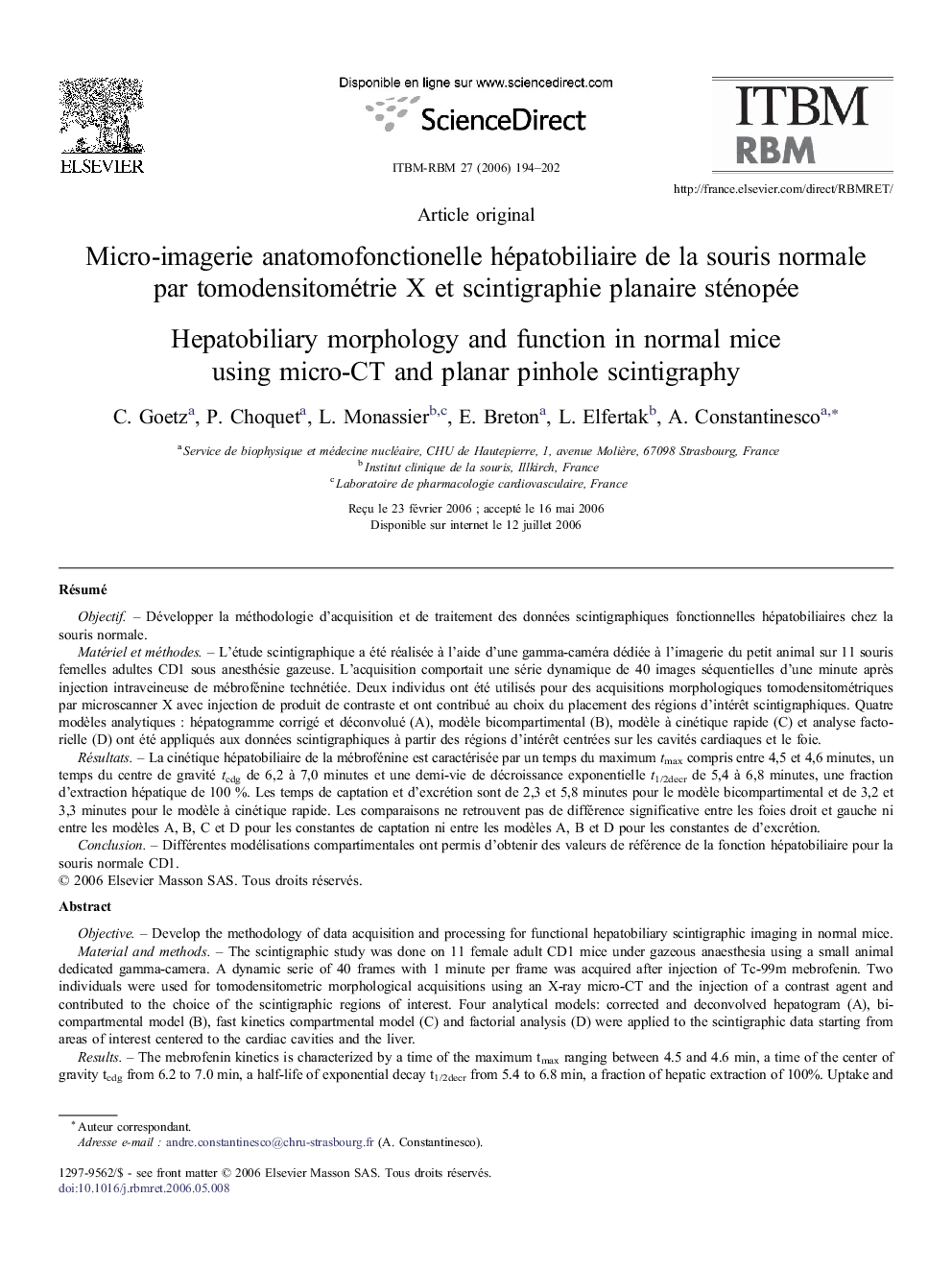| Article ID | Journal | Published Year | Pages | File Type |
|---|---|---|---|---|
| 871643 | ITBM-RBM | 2006 | 9 Pages |
RésuméObjectifDévelopper la méthodologie d'acquisition et de traitement des données scintigraphiques fonctionnelles hépatobiliaires chez la souris normale.Matériel et méthodesL'étude scintigraphique a été réalisée à l'aide d'une gamma-caméra dédiée à l'imagerie du petit animal sur 11 souris femelles adultes CD1 sous anesthésie gazeuse. L'acquisition comportait une série dynamique de 40 images séquentielles d'une minute après injection intraveineuse de mébrofénine technétiée. Deux individus ont été utilisés pour des acquisitions morphologiques tomodensitométriques par microscanner X avec injection de produit de contraste et ont contribué au choix du placement des régions d'intérêt scintigraphiques. Quatre modèles analytiques : hépatogramme corrigé et déconvolué (A), modèle bicompartimental (B), modèle à cinétique rapide (C) et analyse factorielle (D) ont été appliqués aux données scintigraphiques à partir des régions d'intérêt centrées sur les cavités cardiaques et le foie.RésultatsLa cinétique hépatobiliaire de la mébrofénine est caractérisée par un temps du maximum tmax compris entre 4,5 et 4,6 minutes, un temps du centre de gravité tcdg de 6,2 à 7,0 minutes et une demi-vie de décroissance exponentielle t1/2decr de 5,4 à 6,8 minutes, une fraction d'extraction hépatique de 100 %. Les temps de captation et d'excrétion sont de 2,3 et 5,8 minutes pour le modèle bicompartimental et de 3,2 et 3,3 minutes pour le modèle à cinétique rapide. Les comparaisons ne retrouvent pas de différence significative entre les foies droit et gauche ni entre les modèles A, B, C et D pour les constantes de captation ni entre les modèles A, B et D pour les constantes de d'excrétion.ConclusionDifférentes modélisations compartimentales ont permis d'obtenir des valeurs de référence de la fonction hépatobiliaire pour la souris normale CD1.
ObjectiveDevelop the methodology of data acquisition and processing for functional hepatobiliary scintigraphic imaging in normal mice.Material and methodsThe scintigraphic study was done on 11 female adult CD1 mice under gazeous anaesthesia using a small animal dedicated gamma-camera. A dynamic serie of 40 frames with 1 minute per frame was acquired after injection of Tc-99m mebrofenin. Two individuals were used for tomodensitometric morphological acquisitions using an X-ray micro-CT and the injection of a contrast agent and contributed to the choice of the scintigraphic regions of interest. Four analytical models: corrected and deconvolved hepatogram (A), bi-compartmental model (B), fast kinetics compartmental model (C) and factorial analysis (D) were applied to the scintigraphic data starting from areas of interest centered to the cardiac cavities and the liver.ResultsThe mebrofenin kinetics is characterized by a time of the maximum tmax ranging between 4.5 and 4.6 min, a time of the center of gravity tcdg from 6.2 to 7.0 min, a half-life of exponential decay t1/2decr from 5.4 to 6.8 min, a fraction of hepatic extraction of 100%. Uptake and excretion half-lives are 2.3 and 5.8 min for the bicompratmental model and are 3.2 and 3.3 min for the fast kinetics compartmental model. Comparisons do not find significant differences between the right and left livers nor between models A, B, C and D for uptake time constants nor between models A, B and D for excretion time constants.ConclusionReference values of hepatobiliary function in normal CD1 mice were obtained using different compartmental models.
